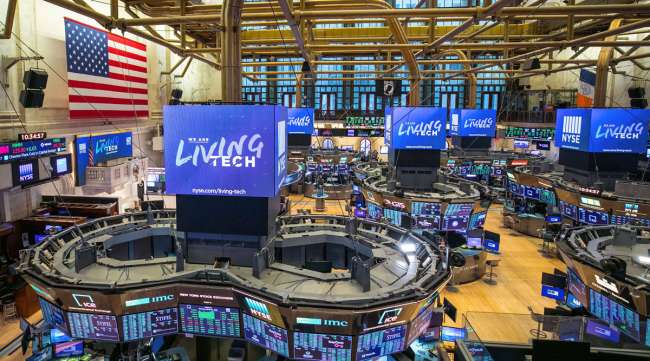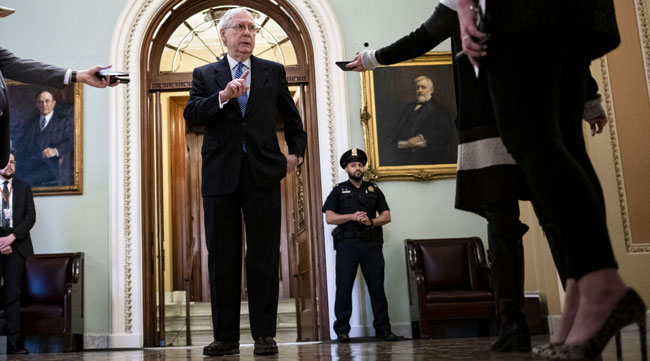Associated Press
Dow Has Best Day Since 1933 as Congress Nears Deal

[Stay on top of transportation news: Get TTNews in your inbox.]
The Dow Jones Industrial Average surged to its best day since 1933 as Congress and the White House neared a deal March 24 to inject nearly $2 trillion of aid into an economy ravaged by the coronavirus.
The Dow burst 11.4% higher, while the more closely followed S&P 500 index leapt 9.4% as a wave of buying around the world interrupted what has been a brutal month of nearly nonstop selling. Despite the gains, investors were far from saying markets have hit bottom. Rallies nearly as big as this have punctuated the last few weeks, and none lasted more than a day.
Both Democrats and Republicans said they’re close on agreeing on a massive economic rescue package, which will include payments to U.S. households and aid for small businesses and the travel industry, among other things. A vote in the Senate could come later March 24 or March 25.
Investors have been waiting in frustration for such aid, particularly as the Federal Reserve has done nearly all it can to sustain markets, including its latest round of extraordinary aid launched March 23.
“I don’t think there’s any more confidence in the fundamental outlook, but the fact that we’re making progress is good news,” said Katie Nixon, chief investment officer at Northern Trust Wealth Management. “It’s sort of like, keep the patient alive in the emergency room so you can provide some treatment options.”
The Dow rose 2,112.98 points, its biggest point gain in history, to 20,704.91. The S&P 500, which is much more important to most 401(k) accounts, rose 209.93 points, or 9.4%, to 2,447.33 for its third-biggest percentage gain since World War II. The Nasdaq composite jumped 557.18 points, or 8.1%, to 7,417.86.
The buying circled the world. South Korean stocks surged 8.6%, Germany’s market jumped 11%, and Treasury yields rose in a sign that investors are feeling less fearful.
The market has seen rebounds like this before, only for them to wash out immediately. Since stocks began selling off Feb. 20, the S&P 500 has had six days where it’s risen, and all but one of them were big gains of more than 4%. After them, stocks fell an average of 5% the next day.
“One of the things to be careful about is thinking this will be the panacea or that this fiscal response will be sufficient,” said Eric Freedman, chief investment officer at U.S. Bank Wealth Management.
Ultimately, investors say they need to see the number of new infections peak before markets can find a floor. The increasing spread is forcing companies to park airplanes, shut hotels and close restaurants to dine-in customers.
Economists are topping each other’s dire forecasts for how much the economy will shrink this spring due to the closures of businesses, and a growing number say a recession seems inevitable.
Some of the market’s areas hardest hit by the closures, though, led the way higher March 24 as expectations rose for incoming aid from the U.S. government.

Senate Majority Leader Mitch McConnell speaks to members of the media in the U.S. Capitol on March 23. (Al Drago/Bloomberg News)
Norwegian Cruise Lines, MGM Resorts and American Airlines Group were all up at least 33%. Energy companies and banks were also strong, though all remain well below where they were a month ago.
Governments and central banks in other countries around the world are unveiling unprecedented levels of support for their economies in an attempt to limit the scale of the upcoming virus-related slump. Germany, a bastion of budgetary discipline, also approved a big fiscal boost.
The gains came even as the first reports arrived showing how badly the outbreak is hitting the global economy. In the United States, a preliminary reading on business activity in March showed the steepest contraction on record, going back to 2009. Reports were also gloomy for Europe.
“Everyone was prepared for a set of shockers, and that is precisely what we got, but they are not a surprise,” said Chris Beauchamp, chief market analyst at IG. “It is at times like this that the market’s propensity to look forward is demonstrated most effectively.”
More dour data is nearly assuredly on the way. On March 26, economists expect a report to show the number of Americans applying for jobless claims easily set a record last week. Some say the number could be way beyond 1 million, amid a wave of layoffs, topping the prior record of 695,000 set in 1982.
Helping to lift sentiment in markets is news from China that it is preparing to lift the lockdown in Wuhan, the epicenter of the outbreak, and from Italy, which is reporting a reduction in the number of new cases and coronavirus-related deaths.
“It’s still early days, of course — perhaps investors can start to envisage life beyond the coronavirus,” said Craig Erlam, senior market analyst at OANDA Europe. “That could make stocks look a little more attractive, although anyone jumping back in now will need to have nerves of steel.”
Want more news? Listen to today's daily briefing:




